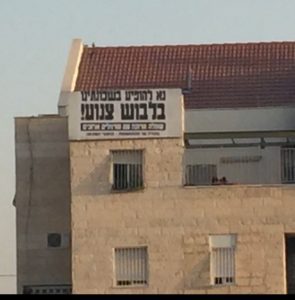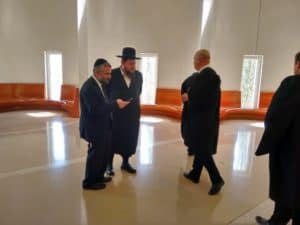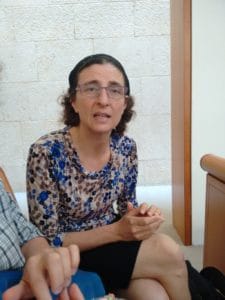Update December 4, 2017 from the Chochmat Nashim Facebook page:
Supreme Court Judge Hanan Meltzer said, “There is no such thing in the State of Israel as a road that is closed to women, nor will there be.
As far as we are concerned, there should be a police presence day and night and any woman who wants to pass should have a police escort.” The judges suggest that the next step is jailtime and tell the city that they have until Sunday to take down the signs and for the police to ensure they don’t go back up.
This article first appeared in the Jerusalem Post’s In Jerusalem supplement on November 14, 2017. Reprinted with permission.

Beit Shemesh modesty sign. Photo: Alisa Coleman
Turf battle in Beit Shemesh
As haredim continue to defy legal rulings against modesty signs,
many have begun to see the city as ‘the canary in the coal mine’
of Israel’s complex secular-religious conflict
• By HANNAH KATSMAN
A large sign with bold black letters hangs on the fifth and highest floor of an apartment building at the street corner near Alisa Coleman’s Beit Shemesh home. Instructing women in “our” neighborhood to appear in modest clothing and signed by “neighborhood residents,” the sign and others like it are part of an ongoing turf war in the increasingly haredi city.
When Coleman first moved to the Sheinfeld neighborhood, she occasionally visited stores in the Kirya Haredit (Haredi Quarter), near the Migdal Hamayim (Water Tower) neighborhood.
“I had no problems, but that was where the first sign appeared.”
The sign proclaimed, “By ruling of the community leader, women are requested to refrain from passing by or loitering on this sidewalk, which is used for those attending the synagogue.” The sign was “donated to the complete repentance of those burning in the furnace of iPhones and the Internet.”
Secular-religious conflict has characterized the State of Israel since its inception. With the increase in the haredi population and with it, political power, the conflict has intensified. In recent months, the radical Jerusalem Faction has staged violent protests in the capital against draft registration. The protests, which included burning tires, blocking streets and throwing trash, caused suffering to the vast majority of the haredi population, both economic and because of the injury to the community’s reputation and influence. This may have led to the posters calling for a boycott of businesses whose owners took part, including the owner of the haredi grocery chain Bar-Kol.
Altercations between the haredim and other residents of Beit Shemesh have also become violent at times. A development town originally populated by North African immigrants in the 1950s, a group of national-religious yeshiva graduates arrived in the 1980s with the aim of strengthening the local population religiously, while benefiting from cheaper housing. Soon English-speaking immigrants discovered Beit Shemesh as an inexpensive and convenient alternative to Jerusalem and Ra’anana, building a large community with seven or eight national-religious synagogues spanning several neighborhoods. The first haredi neighborhoods were built in the 1990s and haredim now make up about half of the city’s population.
According to London-born Coleman, who has lived in Beit Shemesh for 20 years, the trouble began with isolated incidents. “One woman was harassed while running, another hit with a rock while biking. Then the extremists came and pushed into Ramat Beit Shemesh Bet, even nearer to where we live.”
The conflict escalated in 2013, when a national-religious elementary school for girls opened on the border of Ramat Beit Shemesh Bet. The haredim, who largely came from the insular Jerusalem neighborhood of Mea She’arim, wanted the facility fortheir own community. Haredi men lined the sidewalks, hissing and sometimes spitting at the girls as they walked to and from school.
“The people who bought in that neighborhood said, ‘This is our street,’” explains Coleman. “They felt that they bought the street along with the apartments. The Orot [state religious school] girls go to school with three-quarter-length sleeves, so there is no question of modesty.”
Eventually the conflict generated national and international media attention.
“After the publicity,” says Coleman, “the country went crazy, and put pressure on the haredim. It looked bad for them.” The school has since remained free from controversy.
Another street conflict erupted earlier this year when national-religious youth group counselors walking through Ramat Beit Shemesh on Shabbat afternoons were harassed by haredi teenagers, who spit, yelled and threw objects. “It came to a head at Purim time,” recalls Coleman, “when a mob surrounded two of the girls.”
The national-religious teens and their parents met with city and neighborhood leaders, avoiding the media. As with the Jerusalem Faction riots, shaming, presumably from within the extremists’ own community, ended the harassment.
Pashkevilim (posters) went up listing businesses with tax issues and pictures of illegal structures. The posters threatened to pass on damaging information to the authorities.
“Suddenly, things changed,” says Coleman. “Parents were told to keep their kids inside when the counselors walked by. The community didn’t want 100 national-religious adults accompanying eight teenagers. Then representatives of the neighborhood came out and said to the parents, ‘We’ll protect you – we’ll make sure the teenagers [responsible for the harassment] don’t come out.’”
“They’ve controlled it,” concludes Coleman. “There’s a bit of shouting now, but no throwing.”
“We used to believe no one controlled them,” says Coleman.
“We have been walking with the teenagers for three months. The police walked with us while undercover and arrested teens on Shabbat. The system is working better and understands the problem better. Beit Shemesh is the canary in the coal mine. It will happen in other places if not dealt with properly.”
Coleman emphasizes the need to do things legally, without resorting to violence. She and her neighbors support the local haredi businesses and get to know the owners. But she refuses to concede.
“Most people are not interested in spitting at women. But when it becomes allowed to happen, it becomes a norm. Like throwing stones at cars in Mea She’arim. If no one is telling you to stop, there is no deterrent.”
DESPITE THE lawsuits, the modesty signs have remained in place. Opponents claim the massive signs contribute to an intimidating atmosphere and encourage violence. Attorney Orly Erez-Likhovski of the Israel Religious Action Center explained to In Jerusalem why the signs don’t fall under the principles of free speech, even on private property.
“First, the signs look official,” says Erez-Likhovski, “and are signed by rabbis. Yet no permit has been acquired.”
“Second,” she continues, “they are offensive, because they attempt to limit the ability of women to walk in public. In the 2013 report on exclusion of women written by the government’s legal advisory council, there is no mandate for separation of the sexes as a principle of haredi culture. Modesty does not have the same weight as Shabbat observance, for example, and prohibiting the presence of a woman in the public sphere is contrary to the principles of a democratic society.”
With the help of Erez-Likhovski and the Israel Religious Action Center, four women sued the Beit Shemesh Municipality for malpractice, through the local magistrate’s court, in 2013. “Our claim,” says Erez-Likhovski, “is that the signs were not only offensive, but led to physical damages. Judge David Gidoni accepted our claim, awarding NIS 15,000 to each of the four women.”
In 2016, the district court rejected the municipality’s appeal, obligating the city to remove the signs – but they quickly reappeared. In February 2017, the women sued the city for contempt of court. This past June, Supreme Court Judge Yigal Marzel agreed and said that the city would be fined NIS 10,000 for every day the signs remain. Marzel also ordered the city to place cameras at its own expense, and increase police patrols to keep the signs from being replaced.
At the Supreme Court hearing, Mayor Moshe Abutbul of the haredi Shas Party claimed that he had no argument with the law forbidding the signs, which have been up for 15 years. But he expressed fear about entering the neighborhood to take action. “They have overturned a police car and dropped concrete blocks. I’m embarrassed by the violence.”

Beit Shemesh Mayor Moshe Abutbul (left) Photo: Hannah Katsman
Abutbul and the city legal adviser, Mickey Gastwirt, spoke to IJ after the ruling. “The judge understands that it is not simple,” Abutbul said, “The topic is complex.”
“There has been a calming down,” says Gastwirt, citing the resolution of the conflict with the teen counselors. “It has to be through dialogue. There is a war, and we get a lot of complaints about threats. The people who suffer the most are the haredi residents, not the national-religious. But the signs are a symbol. It’s like going to the city of Mosul [in Iraq] and giving [Islamic State] a fine for leaving out garbage.”
He offered reasons for the delay in following the ruling. “The city prosecutor went on maternity leave and others are on vacation,” he explained. “There was no contempt of court. Go deal with the real problems, like the crazy driving on Highway 1, and forget about the signs.”
Attorney Rena Hollander, a resident of Beit Shemesh, recently filled a vacant spot on the city council. “It’s clear that Abutbul doesn’t want to take down the signs,” she says. “I don’t believe for a minute that they can’t be controlled. Abutbul puts up cameras during the day, in full view, and they get taken down immediately. It’s all a show between him and the extremists. He’s winking to them.”
After the hearing, the city removed five signs, but they were immediately replaced. Recently a sixth sign was spotted, asking men and women to stay on opposite sides of a public staircase.
Hollander, who made aliya from Toronto at age 10, served for a year and a half as the only female representative of the city’s religious council. She has recently resigned to take a seat on the city council and provides an insider’s glimpse of the goings-on behind the scenes in the religious council.
“Everything is a big fight. When we bring in speakers, they see it as taking ministry money for liberal women. There is a lot of tension between the haredi and dati leumi [national religious] rabbis surrounding the cemeteries and mikvaot [ritual baths]. Who will make the decisions, who appoints the balaniot [female mikve supervisors]. The haredim don’t even use most of the services. The previous rabbi resigned and instead of appointing someone new, they brought in a very extreme ‘volunteer’ rabbi who makes all of the decisions. There is no other national religious member of the council.”
“The atmosphere in the city is that women shouldn’t be in the public sphere,” Hollander continues. “This radiates into national religious society and even completely secular cities hire more male singers than female. Once it becomes normalized, it’s hard to eradicate – like the buses with separate seating that used to be on only one or two lines. Now there are dozens, even though they are unofficial.
“The signs aren’t irrelevant. I spoke to some extremists during the harassment of teenagers. They said, ‘Don’t you see the signs?’” Hollander included the incident in her report to the court.
Penina (not her real name), a haredi resident of Beit Shemesh, says that some city groups are extremely concerned about staying separate from secular influence.
“I think these signs are not really about tznius [modest dress],” maintains Penina. “It’s more about separation. In Israel, how you dress totally defines your ‘camp.’ Picking on dress is the easiest way to do that.
“Staying separate from foreign influences is a Torah value that’s highly prized in the haredi world,” continues Penina. “But usually not at the expense of other serious mitzvot, like loving your fellow Jew, not embarrassing people, and so on. In my opinion, this is a serious error.”
Rabbi Mordechai Goldstein of the Lev Eliyahu synagogue in the Mishkenot Ya’acov neighborhood of Beit Shemesh told IJ that he doesn’t know about any conflict regarding signs. “There are more important problems,” he says. “Newspaper writers are trying to make trouble. People here are very peaceful.” Other local haredi rabbis refused to comment.

Dr. Eve Finkelstein. Photo: Hannah Katsman
Dr. Eve Finkelstein, a party to the lawsuit, feels that the signs encourage violence. She was attacked by 300 men during a protest against the Egged bus company that she happened to walk into. “They threw rocks at me. It was winter and I was wearing long sleeves and a long skirt,” she recalls. Peaceful means of removing the signs, like mediation, have been ineffective.
“The signs have real-life consequences. A patient of mine was wearing a tank top when she fell and broke her ankle. When she got to the kupah (health clinic) on Hephzibah street, she saw the large modesty sign outside. So she went to the emergency room and had to pay about NIS 800, which the health fund refused to reimburse.
“From their side, they want to have control of the women. From our side, we need there to be a precedent. There are similar signs in Ashdod and Arad, with language about how women should dress. The haredim sent women out to work and opened their eyes. The women are not toeing the line. So the leaders get control through violence and fear.”
Finkelstein describes other attempts to take control.
“It’s a violent haredi sect that wants to enforce its rules,” she declares. “There is a modesty patrol that physically attacked the editors of publications who print ads for lactation consultants, driving lessons for women or for yeshiva students, or for a tzimmer [guest house]. A Sephardi haredi editor allowed ads for driving lessons. They came to his office, poured glue in his door and destroyed his entrance. It rules with violence.
“The secular Jews have a ridiculous respect for haredim. But the haredim have taken things to a place with no connection to Halacha. The secular think it’s a religious issue. But religious men live in North America and Europe. They don’t attack women sexually. Don’t tell me you need the sign to control the men.”
It’s not clear what it will take to resolve this conflict, but perhaps it is simple members of the haredi community who will begin to force change, even incrementally. Notes Finkelstein: “I know a woman from [haredi Beit Shemesh neighborhood] Heftziba who is moving out of the neighborhood after hearing about another woman attacked for a long wig like she herself wears.”
More on Beit Shemesh from A Mother in Israel:
Beit Shemesh Channel 2 Orot documentary
The violence committed by men against women in the name of religion is so disturbing and horrible. What can we do to prevent it from escalating? Thank you for reporting this. Diana